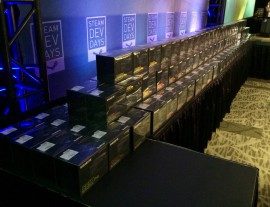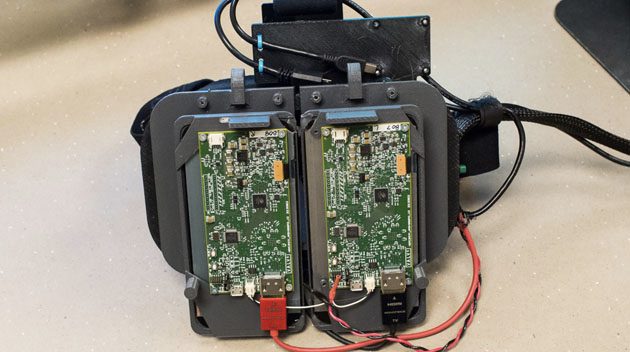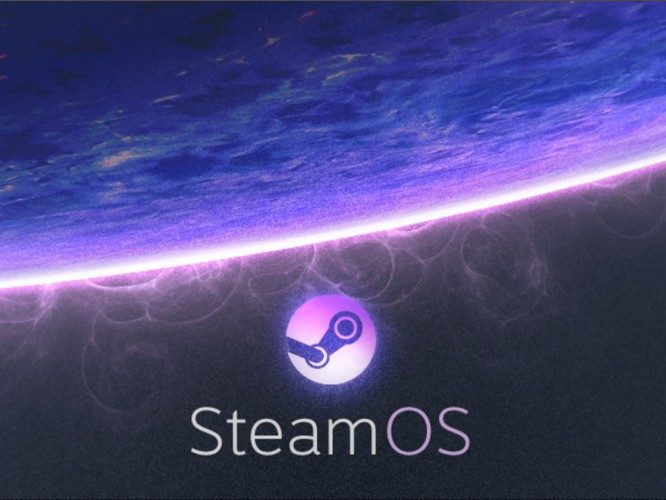Steam OS, Steam Machines, and VR
Steam Dev Days was a timely presentation of technologies and methodologies that Valve have been toiling over for many years now. The themes that made up this year’s event were designed to highlight them not just as a way to further push the Steam ‘product’ but forewarn and educate game developers in the subjects Valve see as key to the next era in the games and home entertainment. To this end the 2 day event was littered with talks designed to help ease developer transition to the Steam platform. More interestingly though was the heavy emphasis on all things VR. Not just demos, but practical advice imparting knowledge Valve and Oculus have gathered since the beginning of their collaboration, which seemed to begin before the Oculus Kickstarter campaign which ran in August of 2012.
Owlchemy Labs were invited to speak at the conference as an example of a commercial realisation of a successful VR project. We wanted to know more about their feeling on how Steam Dev Days went, so here’s a short Q&A with Alex Schwartz (CEO) and Devin Reimer (CTO) in which we try to gather their thoughts on the experience.
Road to VR: How did you come to be at Steam Dev Days and what were your hopes for the event?
Owlchemy: When we first heard about its existence, we were really excited to simply attend this conference but even more so when Valve invited us to speak on Virtual Reality. Dev Days was a first of its kind conference and turned out to be a surprisingly useful event with an amazing group of intelligent and awesome people.
Road to VR: What do you think Valve’s goals were with Steam Dev Days and what do you feel was the event’s message to developers?
Owlchemy: Obviously this is a conference about Steam itself so Valve had an inherent interest in educating Steam developers about new features, new initiatives, and wanted to help convey to their loyal developers their longer term goals. A large chunk of the conference revolved around Steam Machine / Steam Controller concepts as well as virtual reality.
Road to VR: Clearly Steam Machine as a platform featured heavily in the event line up. What are your thoughts on the platform as a developer after the event?
Owlchemy: Yes. Steam Machines were a major point of the conference and it was great move to have all attendees receive a Steam Machine and Steam Controller to start playing around with these technologies. This was a great way to get a lot more people to interact with this hardware prior to release even more important when this is the group of people that will be building content for it.

As for the Steam Machine itself, it is still very early days so a lot of questions are yet to be answered and some things are still being worked out. Initial impressions are mixed—it is great to be able to purchase a device that you can simply plug into your TV and play Steam games without tweaking, setup, adjustment, or too much thinking. Our main concern is that there’s so many of them and the concept of fragmentation comes into play. So far there are 15 or so different Steam Machines announced and each could have different hardware configurations, quality bars, etc. This makes consumer choice incredibly confusing and makes things even worse for developers trying to develop for a min spec. Developers can no longer focus their effort on optimizing their experiences for one Steam Machine or a few and be able to say a future game may run great on it. To compound that problem there is no minimum spec for a Steam Machine, so we can’t even say we will support all Steam Machines because that is out of our hands as developers.
As for the Steam Machine itself, it is still very early days so a lot of questions are yet to be answered and some things are still being worked out. Initial impressions are mixed
Road to VR: What do you see are the biggest benefits to developers in Steam OS / Steam Machine?
Owlchemy: This was talked about a bit above, but the biggest benefit is being able to get games into the living room while leveraging the large Steam library that millions of gamers already possess. If the adoption rate is high enough, this could be a huge play in the living room.
Road to VR: Do you think it’s credible that Valve can make Steam Machine the de-facto standard for virtual reality gaming?
Owlchemy: We feel that Steam could become the de-facto standard for virtual reality, and the Steam Machine would be a conduit for some of those experiences, but we believe the ability to plug a VR headset into a computer is going to be the most important form factor in the short-term.
Road to VR: Can you give us a rundown of your favourite speakers and what they had to say?
Owlchemy: Palmer Luckey’s talk was fantastic! While we had heard his talk concepts before, he is a great presenter with an incredible stage presence and it’s quite hard to avoid feeling like jumping out of your seat and wanting to change the world after hearing him speak. Our talk was directly after him and it was surely a tough act to follow. :)
Road to VR: As developers who embraced VR with Aaaaaaculus! early on, were you able to impart any wisdom to the attendees?
Owlchemy: Our presentation at Steam Dev Days was very well received. It was truly awesome to have 4 VR presentations back-to-back, two by Michael Abrash and Joe Ludwig from Valve, one by Palmer Luckey of Oculus VR, and one by us (Owlchemy Labs). It’s an honor!
There were many topics that we all agreed on, but it was great to see each talk come at these topics from different perspectives. Valve spoke more from a theoretical and prototype approach, Oculus from building the technology and working with 3rd parties, and Owlchemy Labs from actually building a commercial product.
Road to VR: Clearly there was a heavy VR bias to the event’s itinerary, what impact do you think this had on developers previously unaware or uninterested in Virtual Reality?
Owlchemy: Recently, there’s been more and more excitement for virtual reality but no one fully understands it yet. Someone at Valve told us that they were overwhelmed by the amount of excitement for the VR talks at Steam Dev Days that they had to rearrange the rooms, removing tables and jamming as many chairs in as they could. Even then, there wasn’t even standing room left in the rooms, but their choice to stream the talks to an additional overflow room helped to solve that space issue. It’s great to hear other developers starting to understand what we have been saying for a while now regarding the future potential of virtual reality. We’re no longer crazy people. :)
It’s great to hear other developers starting to understand what we have been saying for a while now regarding the future potential of virtual reality. We’re no longer crazy people.
Road to VR: You’ve mentioned you were lucky enough to try out Valve’s prototype HMD. Can you describe what the HMD itself was like (size, weight, resolution, cabling etc)?
Owlchemy: Valve was nice enough to give us both of us (Devin & Alex) a private demo of Valve’s VR prototype. The unit was very much a prototype, it was a larger unit that used two large displays (one for each eye) and the resolution was very high. What made this unit very unique was that it had an outward facing camera which used QR-code-style markers on the walls and ceiling to determine your exact position within 3D space. Lastly this headset was tethered to a computer in the corner of the room with a long cable. We were walked through a number of incredible demos, and the positional tracking accuracy was astonishing. The level of presence was something we had never experienced before.
Road to VR: Can you walk us through your demo experience? The demos, the feelings they instilled, and any standout moments.
Owlchemy: They showed various demos the ones that were the most striking involved scale. Scale is something in VR that so important but also hard to convey unless you have really tried it. The addition of full 3D head tracking made scale even more amazing to experience. From turning around and looking upward to see a 3 story high robot behind you, to kneeling down to see a fully animated miniature office from Portal 2 that was only a couple of inches high. It was pretty cool stuff.
Road to VR: How did you feel after the demo?
Owlchemy: Great! It shows how quickly VR is moving forward. It also showed how cool full 3D head tracking is. We have had done some rough experiments in the labs with full 3D space head tracking and finally seeing a fully realized version of it was wonderful and felt like we hoped it would.
We do feel that for VR to go mainstream, full 3D environment head tracking is not required and that seated head tracking is more than enough for now. The full 3d environment movement does have some huge implications in some spaces, but not for consumer-friendly gaming, in our opinions.
Road to VR: Were the tech demos run on Steam OS? Any clues as to what engine they may have used (perhaps Source Engine 2?)
Owlchemy: We can’t be sure.
Road to VR: We’ve heard the machines that ran the demos were top of the line—any details or feelings on this?
Owlchemy: The computer running this was quite beefy as it was rendering a very high poly scene at very high resolution in VR and also doing full 3D head tracking.
Road to VR: Did you have an opportunity to speak with Michael Abrash, Palmer Luckey, or any of the other speakers at the event?
Owlchemy: After the four VR talks, Devin was lucky enough to go back up on stage with Michael Abrash, Joe Ludwig, and Palmer Luckey in a breakout/QA session for an hour, which was great. Overall, we had lots of great conversations with very interesting people at Steam Dev Days.
—
Thank you Alex and Devin for taking the time to share their experiences and answer our questions. We’re told that recording of all the talks will be made available soon, we’ll keep you updated as when we they appear.
In the mean time, you can visit Owlchemy Labs here and check out Aaaaaaaaaaaaa! on Steam here.








